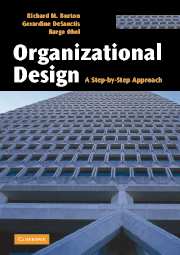Book contents
- Frontmatter
- Contents
- List of figures
- List of tables
- Preface
- An outline of the step-by-step approach
- Step 1 Getting started
- Step 2 Strategy
- Step 3 Structure
- 4 The configuration and complexity of the firm
- 5 Distributed organizations
- Step 4 Process and people
- Step 5 Coordination and Control
- Applying the step-by-step approach in a dynamic world
- References
- Index
5 - Distributed organizations
- Frontmatter
- Contents
- List of figures
- List of tables
- Preface
- An outline of the step-by-step approach
- Step 1 Getting started
- Step 2 Strategy
- Step 3 Structure
- 4 The configuration and complexity of the firm
- 5 Distributed organizations
- Step 4 Process and people
- Step 5 Coordination and Control
- Applying the step-by-step approach in a dynamic world
- References
- Index
Summary
Introduction
In the previous chapter you described the organization in terms of its basic structure. Today many organizations operate in multiple locations and use variants of the basic organizational structures presented in Chapter 4. Distributed organizational designs enable firms to coordinate work across national and other geographic boundaries and meet the knowledge needs of our increasingly service-oriented economy.
This segment of our step-by-step approach consists of two analyses. First, we will assess your organization's approach to organizing across geographic boundaries. Second, we will assess the organization's approach to organizing for knowledge exchange. The variants in structure described in this chapter are sometimes called “new organizational forms” because they represent new twists on classic ways of organizing (DeSanctis & Fulk, 1999; Heydebrand, 1989). The variants described here represent options for designing your firm to meet the demands of today's global, information-intense organization.
When an organization is founded, it typically starts by doing business in one locale. That locale services a particular neighborhood, city, or even an entire country. As the executive managing a business centered in one locale, you become an expert in doing business in that environment. You know the people, the culture, and the general setting in which your firm operates. Your firm becomes highly knowledgeable about that one locale. This allows you to build efficiency and effectiveness based on local knowledge. In addition, doing business with partners, that is, managing relationships with suppliers, distributors, government regulators, and other entities, is relatively straightforward when all are co-located.
- Type
- Chapter
- Information
- Organizational DesignA Step-by-Step Approach, pp. 82 - 106Publisher: Cambridge University PressPrint publication year: 2006



